felt soles, fly fishing stuff, fly fishing wading boots, invasive species, korker, orvis, Review, Simms, sticky rubber wading boots, studded rubber soles, wading boots
The Underground Posts The Mother Of All Rubber Soled Wading Boot Reviews (And Comes to a Few Surprising Conclusions)
By Tom Chandler 4/29/2010
5 minutes
Will New Studded Rubber Soles Kill Felt - Before It's Legislated Away?
Now that
Alaska's announced a statewide felt sole ban - and with a
Vermont ban already in the works (plus New Zealand, plus...) - one thing seems clear.
Some of you may not be wearing felt-soled wading boots much longer.
The topic of felt soles and bans led to a
spirited debate on the Underground, and while the necessity of anti-felt legislation is debatable, the future will likely include bans for at least some of the Undergrounders.
And another reality intrudes; even though I'm not yet legally obligated to wear rubber soles, some of us abandoned felt long ago, and haven't looked back.
In my case, felt was fine when new, but wore quickly on the sharp-edged rocks of the
Upper Sac's railroad tracks. After a few months of hiking along the rails, the grippy felt largely disappeared, the studs protruded, and I was left wearing boots with a truly distressing tendency to skate on smooth, angled rocks.
It's the kind of thing that made both the L&&T and my insurance company break out in a rash.
And dry land performance? Winter performance? Let's not go there.
In simple terms, I haven't conducted a yearlong test of rubber and studded rubber soles because I may one day be forced to wear it.
Instead, I believe it may already be a better all-around choice than felt.
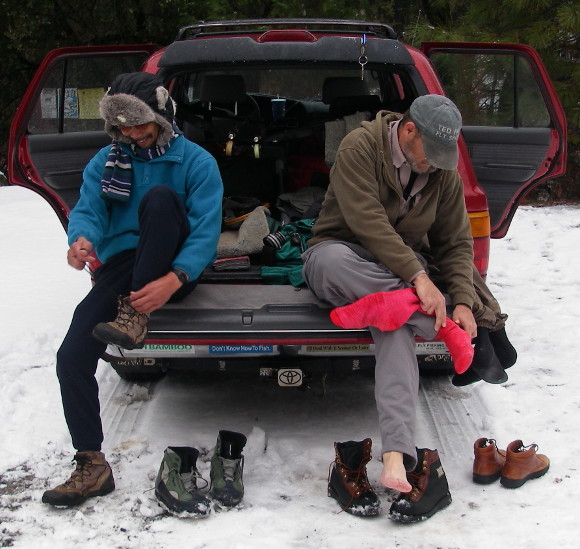
In fact, I'll go a step further: It's possible felt bans may be unnecessary; the bulk of the market could simply move to rubber/studded rubber sans legislation.
That's not what you'd call a universally accepted view - and I'm wary of marketing-driven "green" campaigns against felt - but given my recent testing, it's an idea whose time may have come.
Some Background
For two years after swearing off felt, I wore studded rubber boots from Weinbrenner, which didn't offer anything near the grip of today's rubber soles.
Last year's
initial tests of "sticky rubber" soles were promising, but ultimately, plain rubber soles by Simms, Patagonia, Korkers and others didn't make the cut on tough freestone rivers.
In easier wading situations - like the
Bitterroot or Roque (and most of the Upper Sac), plain sticky rubber worked well enough (better for me than some others, apparently).
And on small streams - where dry grip is as important as wet grip - the soft Patagonia sticky rubber soles were superb (and light, and comfortable).
In other words, modern rubber wading boots have something to offer - but not in hard-to-tough situations.
So What About Studded Rubber Soles?
My on-the-water experience with studded rubber soles is pretty clear; compared to plain rubber, studded rubber soles offer a practical, all-around substitute for felt and studded felt.
The grip on soft surfaces - like slimy, snotty rocks - is much better than straight rubber (as you'd expect).
They also last longer and clean easier than felt (though clean soles are hardly the final solution in the invasives issue).

In my experience, studded rubber also outperforms felt in winter, in icy situations, in mud, and in a few other situations.
And yes, the durability issue means they should offer far more bang for your buck.
But do they grip well enough? Let's see.
Our Lab Rats
I tested the Simms, Korker and the new Orvis studded rubber boots on a notoriously slimy portion of the Upper Sacramento.
(Disclosure: I bought the Patagonia Riverwalkers, but the Simms, Korker and Orvis boots were sent for review. And I'll send 'em back if they want.)
I could have added studs to the Patagonia boots, but like them just the way they are, so I didn't. With studs, I expect they'd work as well - or as poorly - as the boots I tested.
I also tested some screw-in studs from a company called Grip Studs. They feature an interesting design and drop-dead easy application tool, and they're worth a look, though you probably won't be able to buy them at your fly shop.
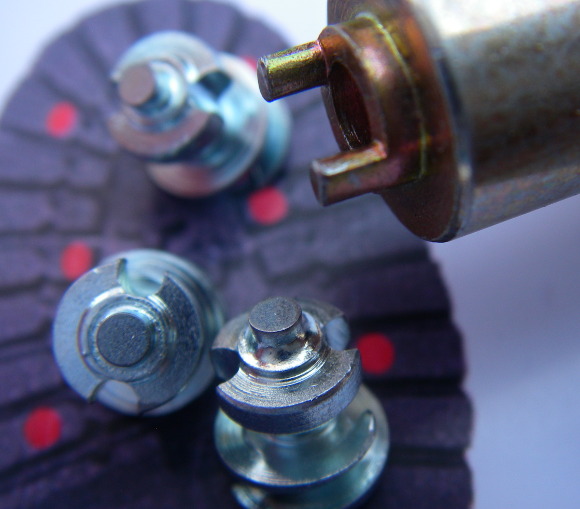
On the river, I waded through what amounted to an underwater obstacle course, and tried to grade the performance of the boots.
I toured bowling-ball sized snot rocks, climbed on dry, steeply angled bankside granite, hit what I called "the Muck Run" and tromped on a few other substrates.
Included was a distressingly effective test where I climbed up on an angled, slippery underwater rock, then tried to see how much downward "oomph" it took to slip the boots.
How's that work? Well, I'm happy to report no one was there to video the scene.
And thrilled to say I got all the boots to finally let go, though never went in over my waders (I am Catman).
Just to make it interesting, I also took the tour with a pair of studded felts (older Weinbrenners), and my old Weinbrenner studded rubber.
Added to the mix were my impressions from all the studded rubber trips taken in the fall and winter. They weren't head-to-head tests (I was fishing after all), but they provided useful information.
The Results
Prepare to not be surprised.
Basically - as you might expect - the modern studded rubber boots delivered similar experiences.
The studded Weinbrenners were exactly as I remembered - solid boots, but lacking grippy rubber, a lugged sole, or much in the way of grip from the small spikes.
In other words, they didn't measure up.
The studded felts did wonderfully on the smooth, curved snot rocks (the soles flex to fit the contour, increasing grip), yet caused me to wish I was wearing a highly absorptive undergarment on the smooth, slanted granite and the big dry rocks.
Was there an Absolute Grip Winner (barely) among the studded rubber contenders?
Barely. But yes.
The Orvis Studded Rubber EcoTraX Soles
The Orvis sole delivered grip similar to the other boots on the firm stuff (rocks, etc), but on softer surfaces (like really thick algae, mud, etc), they clearly outperformed the others (even the studded felt).
The reason for their grip? I'm guessing it's not their sole, but their aggressive, four-bladed stud design.
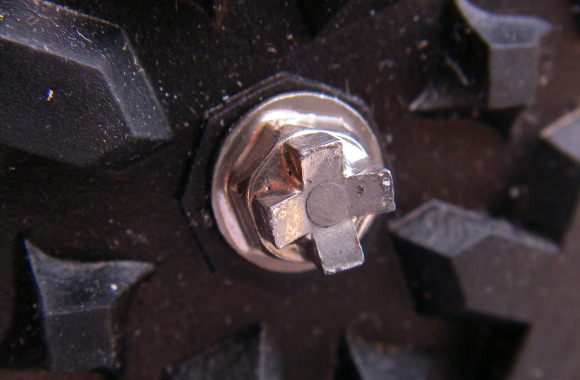
You can see why they'd grip - and why you'd probably only wear these on your brand-new hardwood floors once.
The Orvis soles offered limpet-like grip on the really snotty stuff, and didn't exhibit the less-desireable characteristics I expected (on smooth, dry, angled rocks, they didn't skate).
They're new, so I can't speak to the longevity of the studs.
Yet I can say with some certainty that they're not what you'd call "quiet" on pavement and rocky surfaces.
That said, grip is grip, and these have it in spades.
Notes about the Orvis Boots: Though nicely constructed, these boots ran large. I'm normally a size 11, but needed thick socks and a thick neoprene bootie to make these size 11 boots work (and just barely).
Wearing a normal sock and a thinner neoprene bootie (for wet wading) was a nonstarter - my foot positively swam inside them. Order small, or better, try them on.
The Simms Headwaters Boot
The rubber-soled Simms boots are sold without studs, which are purchased separately and installed. (Note to Simms: How about a stud placement chart?)
I tested the Simms Hard Bite Studs (see below), though they also now offer a more aggressive Hard Bite "Star Cleat" (see below below).
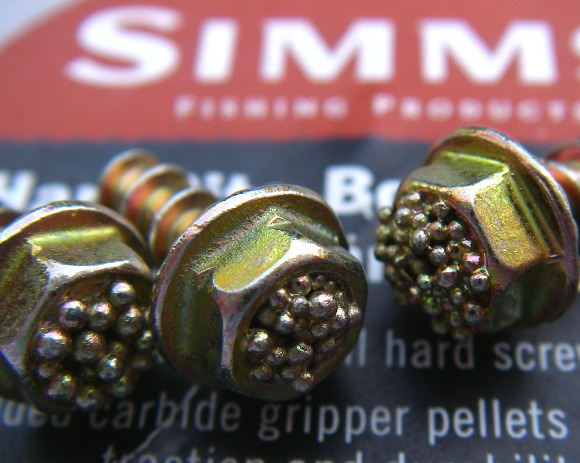
The Hard Bite Studs feature "welded carbide pellets), which seem to offer good all-around performance (especially if you forget and wear them someplace you shouldn't).
The Star Bite studs received positive reviews from several Undergrounders, and their rounded, low-profile design didn't really penalize me in the grip area (I thought they might).
Instead, they were well-behaved, and clearly less damaging to things like car floors, brake pedals, wooden steps and other places you probably shouldn't be wearing them in the first place.
I don't have a set of the Star Cleats available for testing, so I won't comment on them except to say they look aggressive:
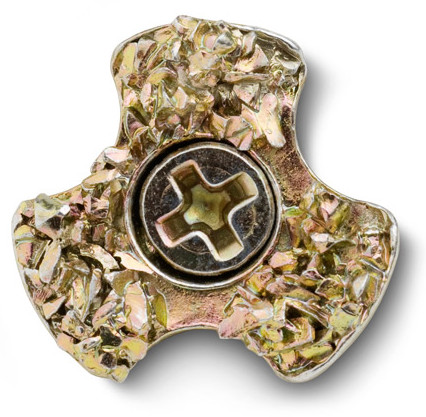
Notes About Simms Boots: The Simms Vibram soles are quite stiff (some like that aspect, though I didn't), and for a "lightweight" wading boot, they offer a very protective environment. The Simms fit relatively true to size, and are rightly famous for their all-around comfort.
The Korkers Guide Boot
The studded rubber soles of the Korkers Guide Boots feature a more "conventional" pointed stud design, though in some ways, these boots were the most revolutionary tested.
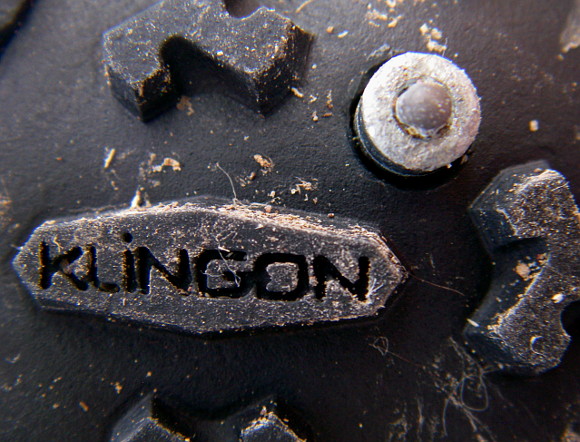
The soles are interchangeable, so you can switch between plain rubber, studded rubber, felt, studded felt, and a wicked-looking, massively spiked "mossy rock lug" sole.
The Korker's changeable soles might ease what I'll call Felt Separation Anxiety Syndrome, though let's be clear; changing the soles is not a 30 second operation, and the extra soles aren't free.
That said, these might be the boots to own if you travel or fish wildly different varying rivers.
Or maybe if you're indecisive and prone to second-guessing (the Underground caters to all fly fishermen).
The Korker soles gripped well; the Kling-on rubber (Korkers fails the Star Trek Geek Test) might be a bit softer than the stiff Vibram soles of the Simms and Orvis, though probably not as soft as the Patagonia boots.
Notes About Korkers Guide Boots: The Korkers featured the BOA lacing system, which eschews shoelaces in favor of a steel cable and ratchet. Adjusting the tension was very easy - even while wearing gloves. That's good because they needed to be tightened a few times before reaching an equilibrium - not an unusual occurrence when dry wading boots get wet.
These boots are also very light and very protective, though they ran a little small (thin socks and thin neoprene make them workable, but you'll want to try these before buying).
A Few Conclusions
It's likely the differences in grip between the boots I tested had more to do with the design of the studs than the rubber soles.
Tom Rosenbauer of Orvis added a layer of mystery when he said via email that: "The key lies in the stud design AND the placement of the studs."
According to him, their studs (and apparently, the placement of them) was the subject of a lot of testing.
I can't swear it's true, but if I was adding studs to a pair of boots and lacked other guidance, I'd be tempted to copy their stud placement.
I'd also suggest the rapidly evolving design of metal studs was narrowing whatever gap still existed between felt and studded rubber.
In most circumstances, studded felt didn't hold much of an edge (if any), and in many ways, the new studded rubber simply outclassed the felt.
Some Good, Lightweight News
All the boots tested were far lighter than my old Weinbrenners, yet offered better protection and stability.
In fact, the Orvis and Simms boots weren't even their most-protective (or heaviest) models, and the Patagonias and Korkers are very light to begin with.
Yet my feet have never felt so sheltered.
And while heavy boots may feed some macho instinct, at the end of a long day of hiking, rock scrambling and wading, lighter is better.
Clearly, not just the soles are seeing improvement.
The Role of Wading Technique
Valuable Tip #2? Learn to wade on a flat foot.
Most people wade like they're walking down the sidewalk; heavy heel strike, feet far apart, and a constant shifting of balance along a narrow line.
That's great for covering a lot of ground in a hurry, but it's pretty much a guaranteed dunking on the river.
Wading so your foot meets the stream bottom relatively flat (the ball of your foot hits about the same time your heel does) might make more difference than any grippy sole ever will.
When wading "normally" it's easy to lose your balance; when you wade on a flat foot, your whole boot tends to squirm down into a solid footing.
The flat foot was why I avoided dunkings with my not-so-grippy Weinbrenner boots, and probably why I'm happier with the straight rubber Patagonia Riverwalkers than other folks.
Add a wading staff to a flat-footed wading technique, and you may never fall again.
The Final Load Out
I think the new studded rubber boots are ready for prime time - at least on my waters.
Over the course of the last year, those waters have included bouldered small streams, meadow streams, spring creeks, and freestone rivers like the Rogue, Bitterroot, McCloud and Upper Sac.
(Perhaps some of our Northwest readers can chime in with their experiences on the NW's hard-to-wade steelhead rivers.)
Some anecdotal evidence suggests studded rubber's also workable on even the "widowmaker" Pit River, though - just like felt soles - every rubber wading boot sole is going to have its good and bad moments

My own personal take? I'm keeping my Patagonia Riverwalkers un-studded - they're just too good to mess with, and I'd happily fish the Upper Sac with them sans studs.
Still, I also fish the McCloud, Klamath and Pit Rivers, and I think a pair of studded rubber boots is in order.
If you're waiting for me to pick one out of the scrum, get ready for a massive letdown.
I suggest choosing the pair that fit you the best.
The exception might come in the form of the Korkers, which offer a flexibility the others don't - but at a price.
Acclimating to studded rubber will require a few changes in thinking. They're better in some areas, but worse in others, and those with hardwired wading reflexes might have to adjust.
That said, they work, and work well - and should last a lot longer.
The first time you wear them, keep in mind what an industry veteran told me on the phone: "The first time someone wearing rubber soles slips, they immediately forget all the times they fell wearing felt."
See you with the rubber side down, Tom Chandler.
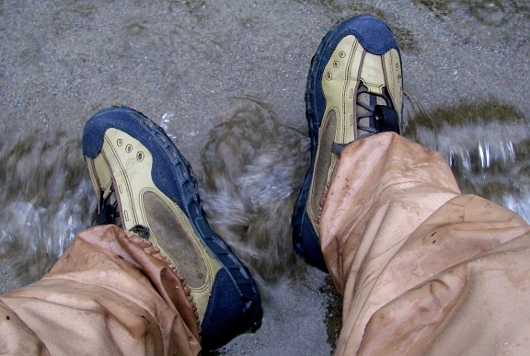
Other Posts in the Wading Boot Review Series Include (in chronological order):
Gear Review: Are Patagonia's Riverwalker Sticky Rubber Wading Boots Grippy or Gimpy?
The Great Rubber-Soled Wading Boot Test Continues: The Guides Weigh In
The Underground's Wading Boot Review Begins a New Chapter
Thoughts On Sticky Rubber Wading Boots, Small Streams, And Marketing
Another Step in the Underground's Ongoing Wading Boot Test
Bans on Felt Soled Wading Boots Gathering Steam: How Long Until You're Wearing Rubber (And Practicing Safe Wading)?

(1)
Nestled in the north end of the Sacramento Valley, Shasta County and its three Cities - Redding, Anderson, and Shasta Lake - are 545 miles north of Los Angeles; 162 miles north of ... moreSacramento; 433 miles south of Portland, Oregon; and 592 miles south of Seattle, Washington.
In 2004, as an effort to increase tourism in the area, the Sundial Bridge, designed by world-renowned architectural designer Santiago Calatrava, was completed. The Sundial Bridge casts its gnomon shadow upon a dial to the north of the bridge accurately once a year during the Summer Solstice. With the objective of providing pedestrian access to the north and south of Turtle Bay Exploration Park, the Sundial Bridge has not only lived up to its purpose but has also become an icon for the City of Redding in the present day.
Redding is one of the best places to launch for Trophy Rainbow Trout & Trophy Steelhead Fishing in Northern California. A number of great rivers are within an easy drive and local guides can on any given day help you figure out where the fishing is great.
The Klamath river, Sacaramento river, Trinity River and the Feather river are all being frequented by local guides and fly fisher.
The Sacramento River is the principal river of Northern California in the United States, and is the largest river in California. Rising in the Klamath Mountains, near Mount Shasta ... more(in Siskiyou county), the river flows south for 445 miles, through the northern section (Sacramento Valley) of the Central Valley, before reaching the Sacramento–San Joaquin River Delta and San Francisco Bay. It forms a common delta with the San Joaquin River before entering Suisun Bay, the northern arm of San Francisco Bay. The river drains about 27,500 square miles, with an average annual runoff of 22 million acre-feet, in 19 California counties, mostly within a region bounded by the Coast Ranges and Sierra Nevada known as the Sacramento Valley, but also extending as far as the volcanic plateaus of Northeastern California.
The McCloud River and its tributaries offer excellent fishing opportunities. The California Department of Fish and Wildlife regularly stocks the Upper McCloud River at Lower Falls ... morewith Rainbow trout. Anglers also occasionally catch German brown trout from earlier stockings or those that traveled up from the McCloud Reservoir, and Brook trout. Remember that the Bull Trout or Dolly Varden is an endangered species and should be released if caught.
The Lower McCloud River, from McCloud Reservoir to Shasta Lake, has been designated a Wild Trout Stream by the California Department of Fish and Wildlife. This portion of the river is not artificially stocked and has special fishing regulations. Only artificial flies and lures with barbless hooks can be used. At the McCloud River Preserve, located one mile below Ah-Di- Na Campground, fishing is limited to catch and release only. Consult the map on the back, and the California Department of Fish and Wildlife Regulations for further details and restrictions.
Endangered species - The McCloud River is the only fishery in California which supports the now rare Bull Trout, also known as the Dolly Varden Trout. Actually a member of the Char family, it is found between Lower Falls and Shasta Lake. Because it is considered an endangered species by the State of California, it must be released if caught.
(1)
Despite pressures from developers, ranchers and farmers, the Bitterroot, a Class 1 river, remains a haven for fly fishers. Flowing through the scenic Bitterroot Valley, the river is ... moreoften referred to as the “banana belt” of Montana, famous for its year round mild climate. Although the river tends to flow through populated areas and is located within the fastest growing area of the state, it’s still possible to see a wide array of animals along its banks including waterfowl, osprey, bald eagles, heron, white deer and mule deer. Wildlife is especially abundant within the Lee Metcalf National Wildlife Refuge, located between Stevensville and Florence.
Like other rivers in Montana, this too has an interesting history. Bitterroot Valley was the ancestral home of the Salish Indians, more commonly known as the Flatheads. The area acquired its name from a plant (later to become Montana’s state flower) that the Salish cultivated and counted on as a major source of food. Father DeSmet, a Jesuit priest, established St. Mary’s Mission here in 1841, and a few years later sold it to John Owen. Owen opened a trading post that over time became Montana’s first permanent, European based settlement, eventually growing into the town of Stevensville. Throughout the remainder of the 19th century, trees were harvested and the river was used to carry logs downstream to Missoula as well as used to support a wide array of agricultural products. Now, aside from sub-divisions, alfalfa is nearly the riverside’s exclusive crop.
Famous for its prodigious insect hatches, the Bitterroot teems with trout. The river carries about 1000 trout per mile, twice that of most similar size rivers, including rainbows, browns and a healthy population of native west-slope, cutthroat trout. This insect rich environment is attributed to the Sapphire Range’s calcium rich, feeder streams that join the Bitterroot and give rise to a large menu of stoneflies, mayflies and caddis. For anyone that might be interested, the river also supports northern pike and largemouth bass in some of its slower moving, backwater currents. A mere 75 miles long, the river passes through several towns including Darby, Hamilton, Corvallis, Victor, Stevensville, Florence, Lolo, ending at Missoula where it combines with the Clark Fork River.
Duration:
4 hours - 8 hours
If you have ever driven over the Lower Sacramento River or even fished it, you know that due to its shear size and abundance of water, this makes it extremely intimidating. That's ... morewhy having a knowledgable Lower Sacramento River Fly Fishing Guide is so important. A great guide will not only put you on the fish, but will also show you the fishy spots accessable by land, the put ins and pull outs for boats, as well as the bug life, the flies to use and when you go on your own, how to put all that t ogether to be successful. The Lower Sacramento River is a big tailwater fishery and California's biggest trout river, and its rainbows are just as big and powerful as the river they live in. If you want big fish and year-round fishing, this is the river for you. With more food than your local all you can eat buffets (2,500 insects per square foot of river), the average fish grows to a healthy and hard-fighting 16-18", and pigs pushing two feet are not out of the question, so bring some big guns. The fishing season is year-round, and water temperatures remain fairly constant too, as the river comes out of the bottom of Shasta Lake.
This river consists of long, indescribable, spring creek like stretches that are broken up by islands, deep pools, long riffles, gravel bars and undulating shelf’s, many of which are more pronounced during lower flows.
If having one of the best trout fisheries in the state isn’t enough, the Lower Sac also hosts some great runs of Steelhead and Chinook salmon too. It also hosts a variety of other fish, such as, shad, squawfish, stripers, largemouth and smallmouth bass, these populations of fish become higher the farther you get away from Shasta Lake. The highest flows are during the summer months, when snow melt is at its greatest, so a drift boat is highly recommended.
You can walk and wade during the higher flows if you so desire, but staying near the bank will be your safest bet. The best time to walk and wade the Lower Sac is going to be during fall, winter and early spring, there is very little snow melt, and the rain that falls goes to filling up the lake, so the river is low and great for walk and wading. This is the time to get out there and really learn the river's bottom and fish those slots that only come out in lower flows, either way “PLEASE WADE WITH CAUTION”. But due to the river’s size and the amount of private property along its banks, those that prefer to wade have two options. One is to fish from public parks and access points along the 16 miles or river between Redding and Anderson, or, from your boat, getting out at the riffles and fishy slots to make some casts.
Public access is fairly easy though on the Lower Sac, there are 6 boat launches, and many public parks and access points along the river that flows almost parallel with interstate 5.
-Brian
Day trips on the Bitterroot River in Montana include an experienced guide, boat, shuttle service to your fishing location, instruction, terminal tackle, leaders and tippet, water, ... morebeverages, and snacks. Alcolholic beverages are not included. Reel in fiesty rainbow and brown trout when you spend a day on the Bitterroot River. Our knowledgeable guides will help you find the best places to go to get them on your line.
(12)
We are a team of friendly and knowledgeable fly fishing guides, with a combined 40 years of fly fishing experience, dedicated to making your adventure on the water with us as enjoyable ... moreand informative as possible. We want you to succeed in all of your fishy endeavors, and we will take the time with you to make sure that you have all the techniques and skills necessary to catch fish wherever you go. Float or Walk and wade with us on one of Northern California's finest rivers and streams and we will accommodate our guiding style to meet your needs and abilities. With our extensive fly fishing knowledge and experience on waters all over Northern California, we will guide you on a fly fishing trip you will not soon forget.
NCFG practices catch and release on all boats. We respect the sport of fishing and wish to give all anglers the opportunity to experience the gratification we strive to give each of our clients.
Tom Chandler
As the author of the decade leading fly fishing blog Trout Underground, Tom believes that fishing is not about measuring the experience but instead of about having fun. As a staunch environmentalist, he brings to the Yobi Community thought leadership on environmental and access issues facing us today.